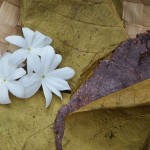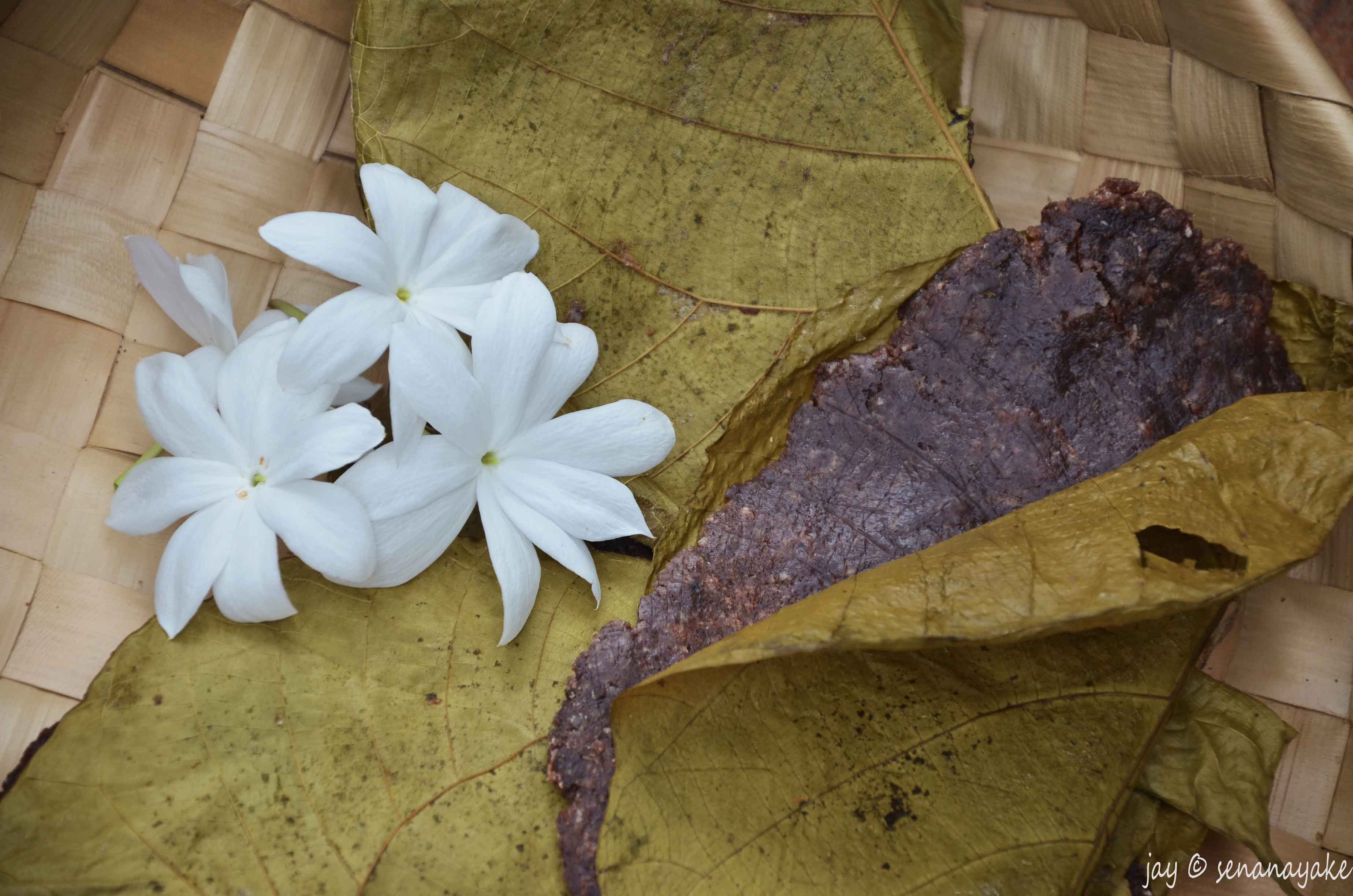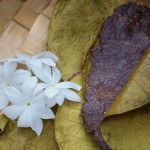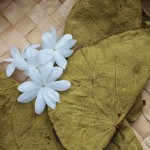If you haven’t eaten helapa, you ain’t Sri Lankan.
I have very fond memories of this traditional Sri Lankan delicacy. My heart skips several beats whenever I see my mother entering the house with an armful of kenda leaves because we know what’s coming – deliciously luscious helapa for afternoon tea! I would sit in the kitchen as she ground the kurakkan and the rice flour and caramelized the kithul treacle on the stove. We can be seen circling the steamer for the first helapa that came out, piping hot, white on kenda green. The whole house filled with that unique mix of fragrances of kurakkan, kenda leaves, cardamom and caramelized treacle and it was all we could do not to reach out and grab one while it was still raw.
Once taken off the stove we would grab at it and tear at the kenda leaves, fingers burning. It is a wonderful impatience, this peeling off the leaf business. A bit like lovemaking really, within those moments of anticipation you hold the apex of your pleasure – seeing, touching, smelling but not really tasting. So much so that first bite of helapa is always satiating. I would burn my fingers and I would burn my tongue beyond all sensation by the end of all that halapa eating, but all that wouldn’t matter because the experience is always rewarding.
Halapa is made in two ways – with the pani pol as a filling or with the pani pol mixed into the flour mixture. In downsouth cuisine they use the panipol as a filling while most halapa we find nowadays are generally made with the pani pol mixed into the flour mixture. My father likes the filling version, I like it the other way. We alternate and make do from time to time!
Halapa is Mother Dearest’s specialty. There is this unspoken rule between us – as long as she does not meddle in my area of expertise, I do not interfere in hers. We are both very dominant and particular in our ways when it comes to food (the men in our lives would raise an eyebrow ‘JUST food’?), so this arrangement works well for us.
So here’s how to make this uniquely Sri Lankan sweet.
Helapa - A traditional Sri Lankan sweet

- Prep Time : 45 minutes
- Cook Time : 30 minutes
- Yield : 15-20 halapa
Ingredients
- Kurakkan flour - 2 cups
- Red rice flour - 1 cup
- Grated coconut - 2 cups
- Kithul treacle - 1 cup
- Sugar - 1/2 cup
- Ground cardamom - 1 tsp
- Pinch of salt
- Large Kenda leaves - 15-20
Instructions
- To make the panipol, heat the treacle on the stove on low heat. Add the sugar and the cardamom. Leave on till all the sugar is dissolved and the syrup thickens.
- Add to this the coconut. Mix it into the syrup and simmer on low heat, frequently stirring until most of the liquid evaporates. Take off heat.
- Mix the kurakkan flour, the rice flour and the salt and sift it together. Add this to the syrup mixture. Mix together until a dough forms of cookie dough consistency.
- Wash and dry the kenda leaves. Take small balls of the halapa dough and flatten it on one side of the kanda leaf (one half from the main vein of the leaf), fold the leaf from the main vein and close the dough with it making a small envelop. Repeat process for all the dough.
- Steam for about ½ hour until the dough firms up. Unwrap and eat!
How can I describe the taste of halapa without having tasted anything quite like it before! Really, it is unique in taste and aroma, the perfect example of when the wrapper and the food merge together to create something so unique. The fragrant earthiness of the kurakkan is further enhanced with the richness of the luscious panipol, fragranced with the subtle perfume of the cardamom lifting it high above. There is a mild leafiness added to this with the kenda leaf. It is this leafy, green flavour and aroma that brings all these varied and contrasting ingredients together.
I stop there because I don’t think I will do this Sri Lankan classic the justice it deserves with my yapping away. The best I can say is, please, do try this – if you can’t bother to make this, at least buy one and try. But then again, good helapa is so hard to find.
If you can’t find kanda leaves I have heard of people making halapa with aluminium foil and banana leaves. I however do not think that it would give off the same taste profile as kanda kola does. For me, if there is no kanda kola, there will be no halapa.
A note on the nutritious value of it. Once again, 100% natural pure, natural Sri Lankan goodness. Kurakkan also known as red millet, finger millet, ragu and koracan with its high levels of amino acid methionine, vitamins, fibre, phytochemicals and various other great nutrients does oodles good for you, fighting against cancer being one of its many merits. It is also very low in calories so it is the ideal diet food for those who are watching their weight. The kithul treacle is 100% natural and made up of so many vitamins with the cardamom adding its antioxidant, anti-inflammatory properties, although it tastes so good, its actually really good for you as well! (Yes that kind exists) The unique thing about Sri Lankan cuisine is this – this rare harmony between great taste and nutrition.
Helpful tips
- When making pani pol, keep the flame on low and make sure you stir it constantly. Otherwise you run the risk of burning the coconut mixture.
- Use good quality kithul treacle and use brown sugar. Brown sugar caramelizes better.
- If you like the helapa with the filling in the middle, prepare the pani pol separately and keep aside. Mix together the kurakkan flour, rice flour and the salt. Bring it together with some warm water into a dough. Flatten the flour dough on the kanda leaf to about 0.25 cm thickness (make it a large circle), place a tablespoonful of the panipol mixture in the middle of it and spread it thick, leaving 1/2 cm from the edges. Seal it up by folding the dough in half and sealing the edges.
I just realized that I am smiling as I am writing this post :) Helapa is awesome! \m/




